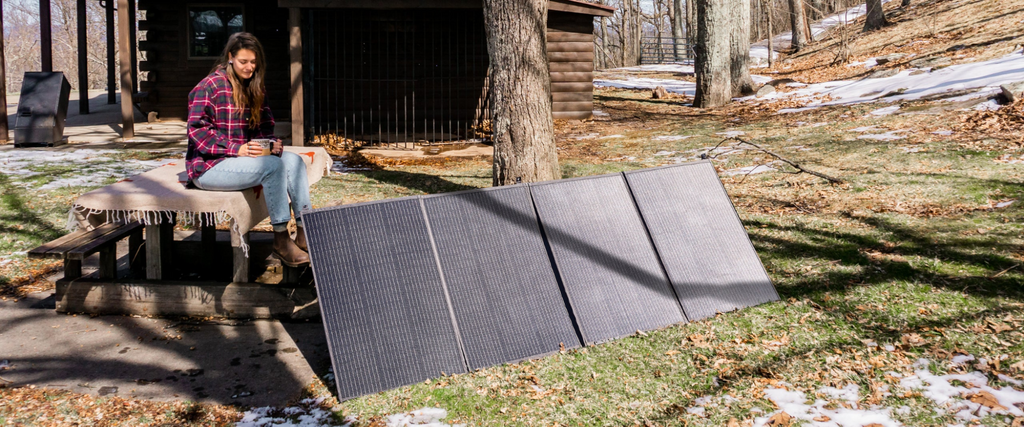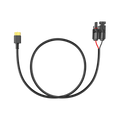Your cart is empty
Shop our productsWith technological advancements, multiple variables of solar panels are available in the market depending on their power production capacity. Among all these, 400-watt solar panels are most commonly used due to the multiple benefits they bring to the table. They are affordable, efficient, and offer good power output.
However, there is a vague understanding of what a 400-watt solar system can run. Knowing this can help you utilize your solar panels more effectively.
This article will help you through all this by discussing their average energy production, what factors affect their capacity, and, on average, how many 400-watt panels you need to run your house.
How Much Electricity Can a 400-Watt Solar Panel Produce?

Before we answer this question, it's important to understand the difference between power and energy. You see, power is the production capacity of a solar panel, while energy is the amount of electricity produced during a specific period of time. To make it simple, let's take the example of a 400-watt solar panel.
The power of this panel is 400 watts, while it generates 1.6 to 2.4 kWh of energy during 4-6 peak sunlight hours under ideal conditions. Practically, this energy production capacity is also dependent on factors like environmental conditions and the availability of sunlight hours.
Below is a table specifying the average energy produced by 400-watt solar panels in different demographic regions of the US.
|
Area |
Daily Energy Produced (kWh) |
Monthly Energy Produced (kWh) |
|
West |
1.3 - 1.5 |
40 - 45 |
|
Midwest |
1.2 - 1.3 |
37 - 40 |
|
North East |
1.1 - 1.2 |
34 - 37 |
|
South East |
1.3 - 1.4 |
40 - 42 |
|
South |
1.4 - 1.5 |
42 - 45 |
Factors Affecting the Energy Production Capacity of 400-Watt Solar Panels

The energy production capacity of solar panels is measured under standard conditions in tech labs. However, due to many external factors, this is rarely applicable in the external world, and factors like temperature, positioning, climate, and panel angles should be taken into account.
Here’s a comprehensive discussion about these factors.
Location
The distribution of sunlight on Earth depends on proximity to the equator. Areas near the equator have more sunlight than those away from the equator. This directly affects the energy production of solar panels. 400-watt solar panels will produce more energy in areas close to the equator than those away from the equator.
Weather conditions
Solar panels only produce energy when enough sunlight is available. In cloudy seasons, solar radiation availability diminishes, ultimately leading to low energy production by solar panels.
Temperature of solar panels
Usually, there is a notion that the higher the temperature, the more energy solar panels will produce. It may sound strange, but if the temperature of solar panels crosses the threshold of 25 centigrade, its energy production capacity decreases.
Installation of panels
The installation angle of solar panels can significantly boost electricity production, as it helps get more peak sunlight hours. To ensure the panel angle does not limit the efficiency of your panel, place it towards the south if you are located in the northern hemisphere, and if you are a resident of the southern hemisphere, tilt the angle towards the north.
Shadow
Energy production through solar panels relies on a simple principle. The more solar radiation reaches solar cells, the more electricity they will generate. Thus, their capacity will be reduced if the panels are shadowed by trees and buildings or covered with dust or ice.
What I Can Run with a 400-Watt Solar System?
There was a time when 400-watt solar panels were the highest-power solar systems available. However, with technological advancements, several other units of high caliber are available in the market. Still, 400-watt solar systems are most commonly used in households due to their high-efficiency ratings.
The average daily energy produced by a 400-watt solar system is around 1.6kW. Depending on that, below is a brief discussion about appliances that you can run with this solar system.
Lighting and Mobile phones: Common LED lights have an energy consumption of around 10-20 Wh. The case is the same with mobile chargers that need 20Wh of power. So you can run multiple LED lights and mobile chargers with a 400-watt solar system.
Fans: Ceiling fans require a higher voltage than LED lights. Still, a 400-watt solar plate can easily support the power needs of a single fan.
TV: Unlike old models, the modern LED TV needs low power, around 50-150 watts, and can be used with a 400-watt solar system. The case is the same with computers that require around 50-200 watts of energy.
If you want to run multiple devices simultaneously or need power for high-voltage appliances, a combination of multiple 400-watt solar panels will be required.
One important point to mention here is that solar panels only convert sunlight into energy and cannot store this energy. To cultivate the maximum out of them, attaching them to a power station is important.
Each power station has its specific capacity to handle a specific number of solar panels according to their power production. BLUETTI offers a wide range of portable power stations that have fast recharge capabilities and are compatible with all household appliances.
How Many 400-Watt Solar Panels Do I Need to Power My House?
The number of solar panels required to run a house is proportional to their energy usage. The more energy consumption there is, the more panels they will need. Besides this, the house's location is an important factor to consider. Solar energy production will be higher in areas with high peak hours as compared to low peak hours.
In an area with an average of 4 peak hours, the power production revolves around 1.6kWh daily and 584kWh per annum. A 2021 survey reveals that the annual power consumption of an average US household was 10600kWh. Using these numbers as case studies, let’s find how many solars you need.
Number of solar panels required = Total annual energy consumption / Output capacity of a panel
Number of solar panels required = 10600kWh/584kWh
Number of solar panels required = 18.15
An average US home will need around 19 panels to run its home. However, it is important to ensure that your installed solar panels have good efficiency ratings of around 20%. Most of the 400-watt solar panels that are available in the market have low-efficiency ratings. BLUETTI PV420, with its 23.4% efficiency, is a torch bearer here. Here is what you can expect from this solar panel.
BLUETTI PV420 Solar Panel | 420W

With an exceptional conversion rating of 23.4%, PV420 solar panels are available in rigid and portable variants. Rigid is the most recommended case for residential installations, while portables can be your reliable energy partner while on the go.
Their installation is very easy as they come with a kickstand. Their long-lasting ETFE coating with multi-layer technology ensures their durability throughout the years. IP65 further makes them splash-proof.
With its portable design, you can easily fold your panels and set them wherever you want with three adjustable angles.
The unit comes with a 1-year hassle-free warranty, lifetime customer support, and a price match guarantee. Simply put, this means if you find any other solar panel of this quality and output ratings at a low price, you can claim the extra amount within 30 days of your purchase.
Specifications
- Power production capacity: 420W
- Manufacturing: IP65, Splash proof
- Weight: 14kg
- Cell Type: Monocrystalline silicon
- Dimension: Folded-975x660x45, Unfolded-2675x975mm
However, one important point is that solar panels do not produce energy at night, and a battery backup is essential to keep your appliances running at night. BLUETTI AC300 is for small homes, and BLUETTI EP900 is best for large homes.
Their power output is 3000W and 9000W, respectively. With a pre-built battery capacity of 3072Wh and 9920Wh, they can keep your home powered for a long time. Their LiFePO4 battery type and battery management system definitely make reliable, effective, environmentally and cost-friendly units.
How Many Amps Does a 400-Watt Solar Generator Produce?
While most appliances have energy consumption in watts, understanding amps could give a better idea about what you can run with a 400-watt solar panel.
The below formula can be used to find amps.
Amps = Watts / Volts
The low-power solar panels produce around 20 volts under optimal conditions. So, for a 400-watt solar panel, let’s assume 40 volts.
Amps = 400/40
Amps = 10
So the average amps production of a 400-watt solar panel is around 10amp per hour. This number could be affected by the unavailability of peak sunlight and optimal temperature.
What Inverter Size Is Good for a 400-Water Solar System?
Inverters or power stations come in multiple variables depending upon their input capacity. For a 400-watt solar panel, the least threshold for input capacity is 400W. However, as your power consumption patterns increase, you will need high storage, input, output, and production capacity.
Inverters could have multiple input streams like solar or AC. Each of these streams has a different capacity. As for an inverter, its solar input could be 1000W, and at the same time, its AC input would be around 500W.
The Bottom Line
A 400-watt solar panel could help you save your energy bills at home or offer a reliable power supply outdoors. Connected with the right power stations, they fulfill the power needs of all home appliances, from mobile phones to refrigerators and ACs.
Get your BLUETTI PV420 Solar Panel, connect it with AC300+B300, and forget about energy bills and power outages. However, if you want more power output or battery capacity, you can explore the vast list of quality BLUETTI products. If you are still confused, call customer support to get the answer to your every question.
Shop products from this article
Be the First to Know
You May Also Like

What Does a 30% Federal Solar Tax Credit Mean and How to Apply?
Governments around the world are offering programs that encourage homeowners to switch to solar energy. Among the most notable programs is the 30% Federal Solar Tax Credit. It reduces your...

Deadly Flooding Devastates U.S. South and Midwest — What You Need to Know

















































































































































































































































